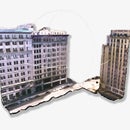Introduction: Digital Sundial- Ancient Tech in Modern Times
The digital sundial speaks to the ancient desire of keeping track of time. A desire probably as old as the concept of time itself; fascination which has lead to very advanced machines. Nonetheless, for thousands of years people relied on the sun (at the time thought) moving around the earth. Some of the first documented time tracking devices date back to Egyptian times where they would raise obelisks and look at the morphing shadow as the day went by.
With this project I wanted to build a simple devise capable of taking us back, appreciating the beauty of time.
Step 1: Math :)
Making a sun dial is not hard but there are a couple of steps one must go through to make it (relatively) accurate.
Location, location, location. Sun dials are very location specific machines (is a sundial a machine??). First you will need to find where you are on the planet. Now a days that can be very easily solved opening google earth and finding yourself, or even looking at your phone's GPS. Take note of the coordinates, you will need them later, in my case they where 37.80, -122.40.
Having this information you can now calculate three things, the angle of your gnomon, the angles for each hour and true north. Sundials are such ancient devices that using modern tech almost feels out of place, nonetheless, if you want to learn more about shadows and the sun, I would really encourage reading about Eratosthenes and how he calculated the circumference of the earth back around the 200BC!
Using AnyCalculator and the numbers recored you can find the angles you need for each hour. In turn, visiting the NGDC (National Geophysical Data Center) you can find the true north which you will need to orient the sundial correctly. To be quite honest, I don't think you need to know where true north is now a days, you could just use another clock to orient the sundial.
Step 2: Modeling & 3D Printing
Using Autodesk Inventor I first started tracing the angles on a sketch, then I created planes that went through the hour lines and the gnomon line. The hard part is done! Using each plane, extrude the right number out of it.
I modeled it in two parts so I could adjust for daylight savings and for ease of 3DP. Both files are attached, keep in mind that these are both for SF latitudes (about 37°) I attached both the base and the gnomon, be ware of the scale since they might be a little too big.
Step 3: Testing!
Who knew... Sundials don't work that well during the night.
When the print came out of the machine the sun had long been hiding, here a quick video of the initial testings.
Step 4: Outdoor Testing! and Painting
Wouldn't it be amazing to have a huge one built in a park?
In the mean time go build your own!















